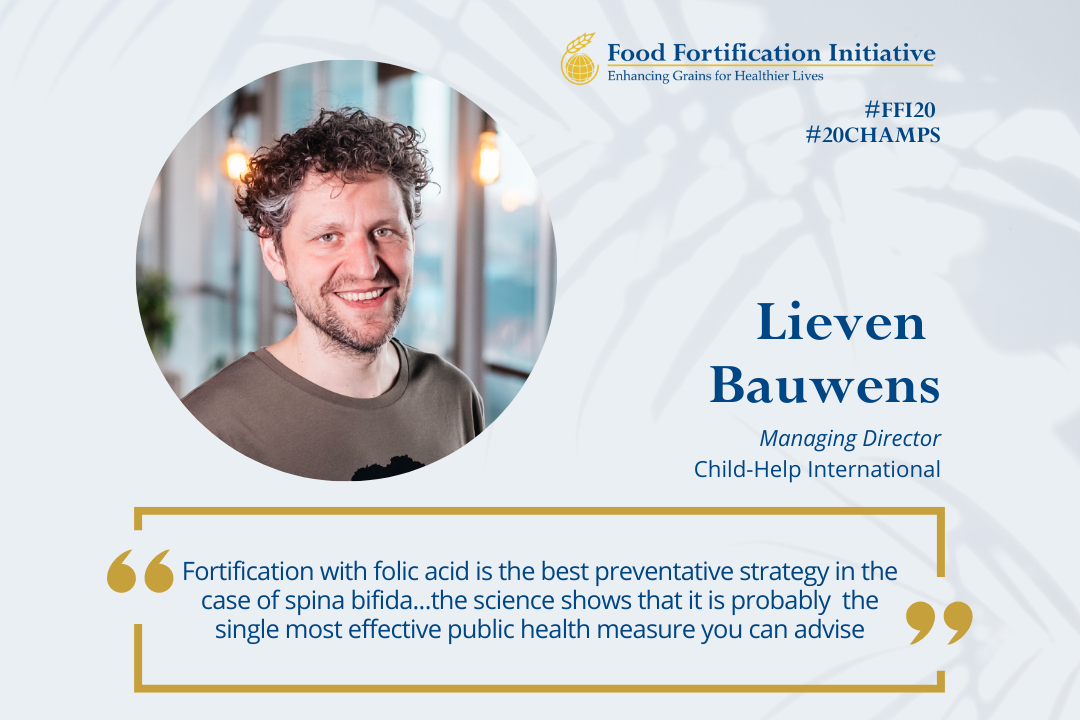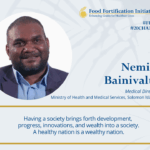Managing Director at Child-Help International

FFI: How did you become interested in nutrition?
Bauwens: This takes me way back to when I started working for the International Federation for Spina Bifida and Hydrocephalus. One of the first things I had to do was guide a process in our general assembly to agree on a joint statement that fortification with folic acid was the best preventative strategy in the case of spina bifida. With that joint statement, it guided my work for the coming years. The link with nutrition was coming from a strategic point of view where the federation [the International Federation for Spina Bifida and Hydrocephalus] was looking at the most effective way of achieving its mission.
FFI: How does the International Federation for Spina Bifida and Hydrocephalus prioritize fortification?
Bauwens: It is a really important component of the work for the International Federation for Spina Bifida and Hydrocephalus. I served as the Secretary-General until 2019. The mission statement of the federation touched on two components: the quality of life and the rights of persons with spina bifida and hydrocephalus and primary prevention.
FFI: What health outcomes do you expect fortification to improve globally?
Bauwens: Coming from my background, we are looking at health outcomes from one specific angle. Many instances of this one specific disability [spina bifida and hydrocephalus] can be prevented with one specific component [consuming at least 400 mcg of folic acid daily before conception and at least 28 days after conception]. Folic acid, once added to staple foods, can help eradicate megaloblastic anemia. There are so many benefits from this one nutrient; scientists find so many improved health outcomes when you improve folic acid status in the population.
FFI: In your experience what are the main components to a successful fortification program?
Bauwens: When we got involved with the Food Fortification Initiative, I really stressed the involvement of people who are directly affected by this type of intervention. Fortification is an intervention that [can prevent] children from being born with spina bifida. This population needs to be involved in the communication and awareness raising around that intervention. A commonality among human rights instruments is that we jointly care for the people who are born with the disability [while also seeking to prevent future disability]. I have always advocated for involving regional and national spina bifida associations and organizations. A fortification program needs to be embedded within the civil society in order to be sustainable.
FFI: What are the greatest challenges you have encountered in planning or implementing fortification programs? And how did you address those challenges?
Bauwens: One of the major challenges is the fact that the baseline is not certain. The stigma is very high surrounding major neural tube defects, so the cultural stigma of these congenital anomalies leads to a tendency to not record cases of spina bifida. Without the evidence, it is really hard to motivate a policy maker to create any new policies. The first question they will always ask is: what type of impact will this have on our population? If we don’t know the baseline, we cannot prove any impact.
FFI: What can we do as a society to continue strengthening fortification efforts?
Bauwens: Data is important: [we need to] set up good surveillance systems and measure truthfully. I think it is important to keep monitoring what is happening to the general health of our population. Ideally people eat healthily, but we know this is often not the case. Fortification can only help the population and continue to show evidence of impact on the population.
FFI: If you were not working in nutrition, what do you think you would be doing?
Bauwens: I became involved with the human rights work within the International Federation for Spina Bifida and Hydrocephalus because I have a brother with spina bifida, so I am personally connected to the disability. I have been in this field for the last seventeen years, and I have no idea what I would have done otherwise. Perhaps farming? I am involved in a local transition movement, which actually still has to do with nutrition. There is a direct relationship between the crops you eat and soil biology, so I have been working a lot in my own country on this.
This interview is part of the #FFI20 Champions campaign, a celebration of fortification heroes who have helped build a smarter, stronger, and healthier world by strengthening fortification programs over the past 20 years. To read interviews with other champions, visit the #FFI20 Champions campaign homepage.



